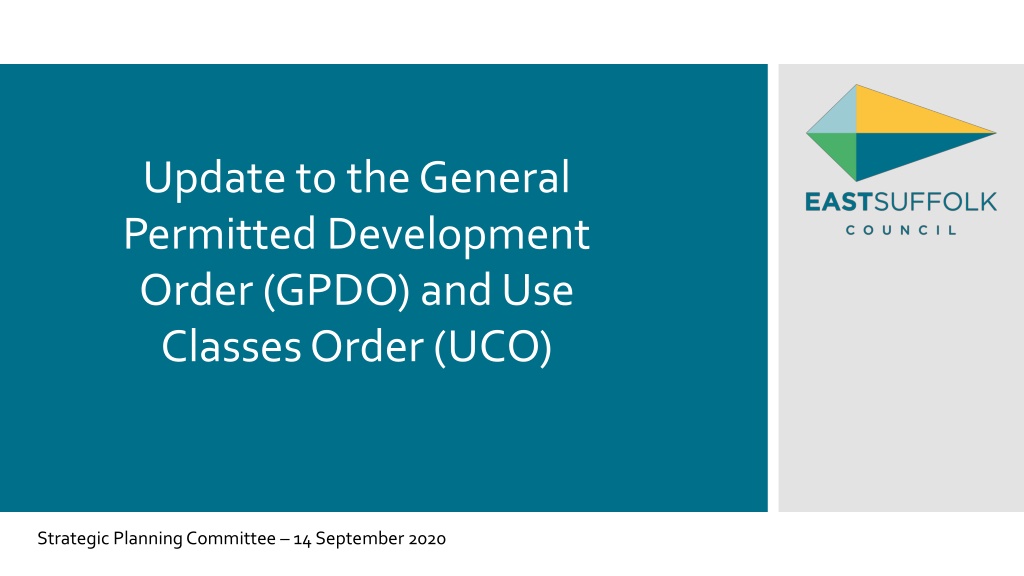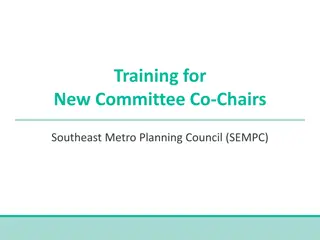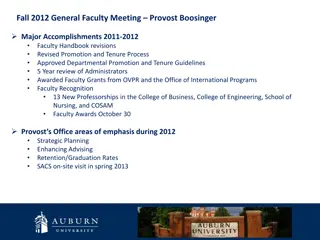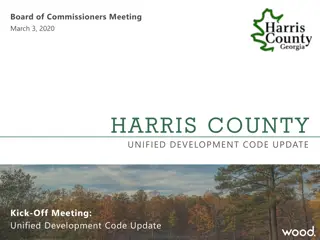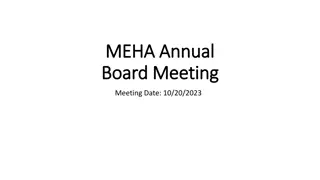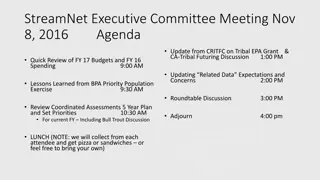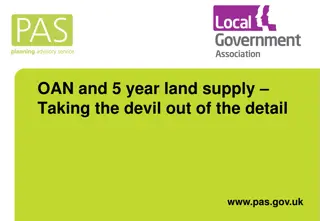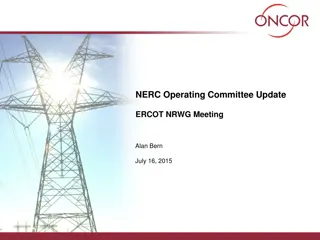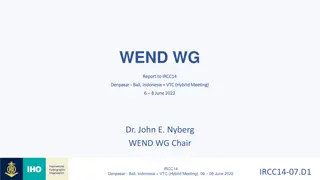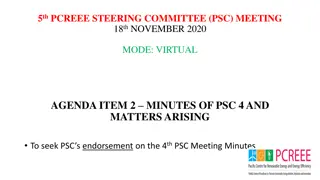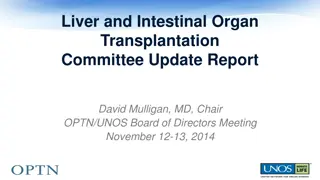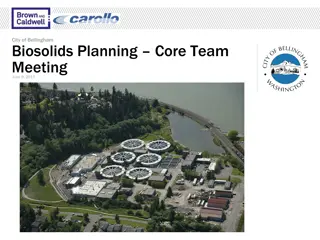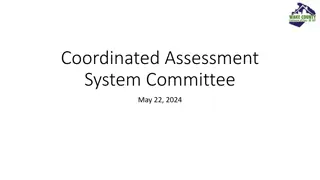Update to GPDO and UCO Regulations: Strategic Planning Committee Meeting Outcome
The recent update to the General Permitted Development Order (GPDO) and Use Classes Order (UCO) includes amendments requiring adequate natural light in habitable rooms of dwellinghouses, with refusal of applications if this criteria is not met. Additional changes now mandate submission of detailed floor plans for validation. New classes introduced under the Town and Country Planning (Permitted Development and Miscellaneous Amendments) Regulations 2020 offer further development opportunities.
Download Presentation

Please find below an Image/Link to download the presentation.
The content on the website is provided AS IS for your information and personal use only. It may not be sold, licensed, or shared on other websites without obtaining consent from the author. Download presentation by click this link. If you encounter any issues during the download, it is possible that the publisher has removed the file from their server.
E N D
Presentation Transcript
Update to the General Permitted Development Order (GPDO) and Use Classes Order (UCO) Strategic Planning Committee 14 September 2020
Regulations under the Town and Country Planning (Permitted Development and Miscellaneous Amendments) (England) (Coronavirus) Regulations 2020 come into force between 25th June and 1st August 2020. https://www.legislation.gov.uk/uksi/2020/632/contents/made GPDO https://www.legislation.gov.uk/uksi/2020/756/article/4/made https://www.legislation.gov.uk/uksi/2020/755/article/3/made
Part 3 Class M, N, O, P, PA & Q now include the requirement for: The provision of adequate natural light in all habitable rooms of the dwellinghouses GPDO Part 3 Amendment to Part 3, paragraph X habitable rooms means any rooms used or intended to be used for sleeping or living which are not solely used for cooking purposes, but does not include bath or toilet facilities, service rooms, corridors, laundry rooms, hallways or utility rooms
This also allows applications under M, N, O P, PA & Q to be refused if natural light is not provided: (2A) Where the application relates to prior approval as to adequate natural light, the local planning authority must refuse prior approval if adequate natural light is not provided in all the habitable rooms of the dwellinghouses. . GPDO Part 3
Amendment to Part 3, paragraph W 18. In paragraph W of Part 3 of Schedule 2 (a)after sub-paragraph (2)(bb) insert (bc)in relation to development proposed under Class M, N, O, PA or Q of this Part, a floor plan indicating the dimensions and proposed use of each room, the position and dimensions of windows, doors and walls, and the elevations of the dwellinghouses; ; GPDO Part 3 For validation purposes this means that applications are invalid now if a plan with all of these requirements is not submitted.
Regulations under the Town and Country Planning (Permitted Development and Miscellaneous Amendments) (England) (Coronavirus) Regulations 2020 also includes some additional Classes: Schedule 2 Part 1: Class AA enlargement of a dwellinghouse by construction of additional storeys Schedule 2 Schedule 2 Part 20: Class ZA Demolition of buildings and construction of new dwellinghouses in their place Class A New dwellinghouses on detached blocks of flats Class AA - new dwellinghouses on detached buildings in commercial or mixed use Class AB - new dwellinghouses on terrace buildings in commercial or mixed use Class AC - new dwellinghouses on terrace buildings in use as dwellinghouses Class AD - new dwellinghouses on detached buildings in use as dwellinghouses
Schedule 2 Part 1: Class AA enlargement of a dwellinghouse by construction of additional storeys AA. The enlargement of a dwellinghouse consisting of the construction of Schedule 2 Part 1 Class AA (a) up to two additional storeys, where the existing dwellinghouse consists of two or more storeys; or (b) one additional storey, where the existing dwellinghouse consists of one storey, immediately above the topmost storey of the dwellinghouse, together with any engineering operations reasonably necessary for the purpose of that construction
Class AA development is not permitted if: (a)Development was allowed under M, N, O, P, PA or Q (b)Article 2(3) land (Conservation Area) or SSSI (c) Dwellinghouse constructed before 1st July 1948 or after 28th October 2018 (d) The existing dwelling has been enlarged by one or more storeys already (e) Height of the highest part of the roof would exceed 18m (f) following the development the height of the highest part of the roof of the dwellinghouse would exceed the height of the highest part of the roof of the existing dwellinghouse by more than (i) 3.5 metres, where the existing dwellinghouse consists of one storey; or (ii) 7 metres, where the existing dwellinghouse consists of more than one storey; (g) the dwellinghouse is not detached and following the development the height of the highest part of its roof would exceed by more than 3.5 metres (i) in the case of a semi-detached house, the height of the highest part of the roof of the building with which it shares a party wall (or, as the case may be, which has a main wall adjoining its main wall); or (ii) in the case of a terrace house, the height of the highest part of the roof of every other building in the row in which it is situated; (h) the floor to ceiling height of any additional storey, measured internally, would exceed the lower of (i) 3 metres; or(ii) the floor to ceiling height, measured internally, of any storey of the principal part of the existing dwellinghouse; (i) any additional storey is constructed other than on the principal part of the dwellinghouse; (j) the development would include the provision of visible support structures on or attached to the exterior of the dwellinghouse upon completion of the development; or (k) the development would include any engineering operations other than works within the curtilage of the dwellinghouse to strengthen its existing walls or existing foundations.
Class AA is also subject to conditions: (a) the materials used in any exterior work must be of a similar appearance to those used in the construction of the exterior of the existing dwellinghouse; (b) (b) the development must not include a window in any wall or roof slope forming a side elevation of the dwelling house; (c) the roof pitch of the principal part of the dwellinghouse following the development must be the same as the roof pitch of the existing dwellinghouse; and (d) following the development, the dwellinghouse must be used as a dwellinghouse within the meaning of Class C3 of the Schedule to the Use Classes Order and for no other purpose, except to the extent that the other purpose is ancillary to the primary use as a dwellinghouse.
Class AA is subject to prior approval which can consider: (i) impact on the amenity of any adjoining premises including overlooking, privacy and the loss of light; (ii) the external appearance of the dwellinghouse, including the design and architectural features of (aa) the principal elevation of the dwellinghouse, and (bb) any side elevation of the dwellinghouse that fronts a highway; (iii) air traffic and defence asset impacts of the development; and (iv) whether, as a result of the siting of the dwellinghouse, the development will impact on a protected view identified in the Directions Relating to Protected Vistas dated 15th March 201244 issued by the Secretary of State; (b) before beginning the development, the developer must provide the local planning authority with a report for the management of the construction of the development, which sets out the proposed development hours of operation and how any adverse impact of noise, dust, vibration and traffic on adjoining owners or occupiers will be mitigated; (c) the development must be completed within a period of 3 years starting with the date prior approval is granted; (d) the developer must notify the local planning authority of the completion of the development as soon as reasonably practicable after completion
Schedule 2 Part 20: Class ZA Demolition of buildings and construction of new dwellinghouses in their place Class ZA allows for demolition of buildings and construction of dwellinghouses. Schedule 2 Part 20 Class ZA Buildings can be flats, a single detached building in B1(a), (b), (c) and the replacement must be a single building either as a block of flats, or a detached dwellinghouse. Development is not permitted if the site is under designations, including: Article 2(3) land (Conservation Area, AONB) SSSI Listed Building or Curtilage Scheduled monument or curtilage
Development is not permitted under ZA: (b) If the old building was constructed after 31/12/1989 (c)If the footprint exceeds 1000sq m (d) If the height is greater than 18m above the old building (e) Unless the old building has been vacant for a period of at least 6 months immediately prior to the date of the application for prior approval; (h) if any of the footprint of the new building falls outside the footprint of the old building (i) if any part of the exterior wall of the new building nearest to a highway is nearer to the highwaythan the part nearest the highway of the exterior wall nearest the highway of the old building;
Also development is not permitted under ZA: (j) if the height (not including plant, radio masts and antennae) of the new building would at any point exceed the lower of (i) 7 metres above the height (not including plant) of old building; or (ii) 18 metres, above ground level; (k) if the new building has more than X + 2 storeys, where X is the number of storeys in the old building; (l) if the new building has more storeys than the old building and the floor to ceiling height of any additional storey in the new building, measured internally, would at any point be greater than the lower of (i) the floor to ceiling height, measured internally, of any storey in the old building; or (ii) 3 metres; or (m) if the height of any plant on the roof of the new building as measured from the lowest surface of that roof would be greater than the height of any existing plant as measured from the lowest surface of the existing roof on the principal part of the old building.
Class ZA is also subject to prior approval which can consider: (a) transport and highways impacts of the development; (b) contamination risks in relation to the new building; (c) flooding risks in relation to the new building; (d) the design of the new building; (e) the external appearance of the new building; (f) the provision of adequate natural light in all habitable rooms of each new dwellinghouse in or comprising the new building; (g) the impact of the development on the amenity of the new building and of neighbouring premises, including overlooking, privacy and light; (h) impacts of noise from any commercial premises on the intended occupiers of the new dwellinghouses; (i) the impact on business and new residents of the development s introduction of, or increase in, residential use in the area in which the development is to take place; (j) the impact of the development on heritage and archaeology; (k) the method of demolition of the old building; (l) the plans for landscaping of the development, including the planting and maintenance of shrubs and trees; and (m) any (i) air traffic and defence asset impacts of the development, and (ii) impact that, because of the siting of the new building, the development will have on a protected vista identified in the Directions Relating to Protected Vistas dated 15 March 2012 by the Secretary of State175, unless no part of the new building (including plant, radio masts and antennae) occupies airspace not occupied by the old building (including plant, radio masts and antennae).
Class ZA is also subject to conditions: (5) Any development under Class ZA is permitted subject to the condition that it must be completed within a period of 3 years starting with the date prior approval is granted. (6) Any development under Class ZA is permitted subject to the condition that before beginning the development, the developer must provide the local planning authority with a report for the management of the construction of the development, which is acceptable to the authority and sets out the method of demolition, the proposed development hours of operation and how any adverse impact of noise, dust and vibration and traffic on occupiers of the new building and adjoining owners or occupiers will be mitigated, the proposed use of materials, and the plans for the disposal and recycling of waste generated by the development and that in carrying out the development the developer must comply with the report. (9) Any new dwellinghouse created under Class ZA is to remain in use as a dwellinghouse within the meaning of Class C3 of the Schedule to the 1987 Order and for no other purpose, except to the extent that the other purpose is ancillary to the primary use as a dwellinghouse.
Schedule 2 Part 20: Class AA - new dwellinghouses on detached buildings in commercial or mixed use Construction of up to two additional storeys of new dwellinghouses immediately above the existing topmost residential storey on a building which is a purpose-built, detached block of flats, Development is not permitted by Class A if (a) the permission to use any building as a dwellinghouse has been granted only by virtue of Class M, N, O, P, PA or Q of Part 3 of this Schedule; (b) (b) above ground level, the building is less than 3 storeys in height; (c) the building was constructed before 1st July 1948, or after 5th March 2018; (d) the additional storeys are constructed other than on the principal part of the building; (f) the new dwellinghouses are not flats; (g) the height of the highest part of the roof of the extended building would exceed the height of the highest part of the roof of the existing building by more than 7 metres (not including plant, in each case); (h) the height of the highest part of the roof of the extended building (not including plant) would be greater than 30 metres; (o) the land or site on which the building is located, is or forms part of (i) article 2(3) land (AONB, Conservation Area); (ii) a site of special scientific interest; (iii) a listed building or land within its curtilage; (iv) a scheduled monument or land within its curtilage; Schedule 2 Part 20 Class AA
Class AA is also subject to prior approval which can consider (a) transport and highways impacts of the development; (b) air traffic and defence asset impacts of the development; (c) contamination risks in relation to the building; (d) flooding risks in relation to the building; (e) the external appearance of the building, including (i) the design and architectural features of (aa) the principal elevation; and (bb) any side elevation that fronts a highway; and (ii) the impact of any works under sub-paragraph (1)(c) or (d) of Class AA; (f) the provision of adequate natural light in all habitable rooms of the new dwellinghouses; (g) impact on the amenity of the existing building and neighbouring premises including overlooking, privacy and the loss of light; (h) impacts of noise from any commercial premises on the intended occupiers of the new dwellinghouses; (i) impacts of the introduction of, or an increase in, a residential use of premises in the area on the carrying on of any trade, business or other use of land in the area; (j) whether, because of the siting of the building, the development will impact on a protected view identified in the Directions Relating to Protected Vistas dated 15th March issued by the Secretary of State,
Class AA is also subject to conditions: 3) Any development under Class AA is permitted subject to the condition that it must be completed within a period of 3 years starting with the date prior approval is granted (4) Any development under Class AA is permitted subject to the condition that before beginning the development, the developer must provide the local planning authority with a report for the management of the construction of the development, which sets out the proposed hours of operation and how any adverse impact of noise, dust, vibration and traffic on occupiers of the building and adjoining owners or occupiers will be mitigated. (5) The developer must notify the local planning authority of the completion of the development as soon as reasonably practicable after completion. (7) Following the development, every dwellinghouse in the building must remain in use as a dwellinghouse within the meaning of Class C3 of the Schedule to the Use Classes Order and for no other purpose, except to the extent that the other purpose is ancillary to the primary use as a dwellinghouse.
Schedule 2 Part 20: Class AB - new dwellinghouses on terrace buildings in commercial or mixed use Development consisting of works for the construction of new dwellinghouses immediately above the topmost storey on a terrace building to which sub-paragraph (2) applies, where that development comprises (a) up to two additional storeys, in the case of an existing building consisting of two or more storeys; (b) one additional storey, in the case of an existing building consisting of one storey, together with any development under sub-paragraph (3). Schedule 2 Part 20 Class AB (2) This sub-paragraph applies to a building which is (a) used for any purpose within Class A1 (shops), Class A2 (financial and professional services), Class A3 (restaurants and cafes) or Class B1(a) (offices) of the Schedule to the Use Classes Order, or as a betting office, pay day loan shop or launderette; (b) in a mixed use combining (i) two or more uses within paragraph (a); or (ii) a use falling within Class C3 (dwellinghouses) of the Schedule to the Use Classes Order, together with one or more uses within paragraph (a).
Development is not permitted by Class AB if- (a) the building was constructed before 1st July 1948 or after 5th March 2018; (b) on 5th March 2018 the building was in a use other than (i) a use or mixed use within paragraph AB(2)(a) or (b); or (ii) a use falling within Class C3 of the Schedule to the Use Classes Order; (c) the additional storeys are constructed other than on the principal part of the building; (e) the new dwellinghouses are not flats; (f) the height of the highest part of the roof of the extended building (not including plant) would be greater than 18 metres; (g) the height of the highest part of the roof of the extended building would exceed by more than 3.5 metres the height of the highest part of the roof of every other building in the row of terrace buildings of which it forms part (not including plant, in each case); (h) the height of the highest part of the roof of the extended building would exceed the height of the highest part of the roof of the existing building (not including plant, in each case) by more than (i) 3.5 metres, where the existing building consists of one storey; or (ii) 7 metres, where the existing building consists of more than one storey; (i) the existing building has been enlarged by the addition of one or more storeys above the original building, whether in reliance on permission granted under this Part or otherwise; (j) development under Class AB(3)(a) would include the provision of visible support structures on or attached to the exterior of the building upon completion of the development; (p) the land or site on which the building is located, is or forms part of (i) article 2(3) land (AONB, Conservation Area); (ii) a site of special scientific interest; (iii) a listed building or land within its curtilage; (iv) a scheduled monument or land within its curtilage;
Class AB is also subject to prior approval which can consider (a) transport and highways impacts of the development; (b) air traffic and defence asset impacts of the development; (c) contamination risks in relation to the building; (d) flooding risks in relation to the building; (e) the external appearance of the building, including (i) the design and architectural features of (aa) the principal elevation; and (bb) any side elevation that fronts a highway; and (ii) the impact of any works under paragraph AB(3)(c) or (d); (f) the provision of adequate natural light in all habitable rooms of the new dwellinghouses; (g) impact on the amenity of the existing building and neighbouring premises including overlooking, privacy and the loss of light; (h) impacts of noise from any commercial premises on the intended occupiers of the new dwellinghouses; (i) impacts of the introduction of, or an increase in, a residential use of premises in the area on the carrying on of any trade, business or other use of land in the area; (j) whether, because of the siting of the building, the development will impact on a protected view identified in the Directions Relating to Protected Vistas dated 15th March 2012179 issued by the Secretary of State, and the provisions of paragraph B (prior approval) of this Part apply in relation to that application.
Class AB is also subject to conditions: (3) Any development under Class AB is permitted subject to the condition that the development must not include a window in any wall or roof slope forming a side elevation of the building. (4) Any development under Class AB is permitted subject to the condition that it must be completed within a period of 3 years starting with the date prior approval is granted. (5) Any development under Class AB is permitted subject to the condition that before beginning the development, the developer must provide the local planning authority with a report for the management of the construction of the development, which sets out the proposed development hours of operation and how any adverse impact of noise, dust, vibration and traffic on occupiers of the building and adjoining owners or occupiers will be mitigated. (6) The developer must notify the local planning authority of the completion of the development as soon as reasonably practicable after completion. (8) Following the development, every dwellinghouse in the building must remain in use as a dwellinghouse within the meaning of Class C3 of the Schedule to the Use Classes Order and for no other purpose, except to the extent that the other purpose is ancillary to the primary use as a dwellinghouse.
Schedule 2 Part 20: Class AC - new dwellinghouses on terrace buildings in use as dwellinghouses Development consisting of works for the construction of new dwellinghouses immediately above the topmost storey on a terrace building in use as a single dwellinghouse within the meaning of Class C3 of the Schedule to the Use Classes Order, where the development comprises Schedule 2 Part 20 Class AC (a) up to two additional storeys, in the case of an existing dwellinghouse consisting of two or more storeys; (b) one additional storey, in the case of an existing dwellinghouse consisting of one storey
Development is not permitted by Class AC if (a) the building was constructed before 1st July 1948 or after 5th March 2018; (b) on 5th March 2018 the building was in a use other than (i) a use falling within Class C3 (dwellinghouses) of the Schedule to the Use Classes Order;or (ii) a use or mixed use within paragraph AA(2)(a) or (b) of this Part; (c) the additional storeys are constructed other than on the principal part of the dwellinghouse; (d) the floor to ceiling height of any additional storey, measured internally, would exceed the lower of (i) 3 metres; or (ii) the floor to ceiling height, measured internally, of any storey of the principal part of the existing dwellinghouse; (e) the new dwellinghouses are not flats; (f) the height of the highest part of the roof of the extended building would be greater than 18 metres; (g) the height of the highest part of the roof of the extended building would exceed by more than 3.5 metres the height of the highest part of the roof of every other building in the row of terrace buildings of which it forms part; (h) the height of the highest part of the roof of the extended building would exceed the height of the highest part of the roof of the existing dwellinghouse by more than (i) 3.5 metres, where the existing dwellinghouse consists of one storey; or (ii) 7 metres, where the existing dwellinghouse consists of more than one storey; (i) the existing dwellinghouse has been enlarged by the addition of one or more storeys above the original dwellinghouse, whether in reliance on permission granted under Class AA of Part 1 or otherwise; (k) development under Class AC(2)(a) would consist of engineering operations other than works within the existing curtilage of the dwellinghouse to (m) development under Class AC(2)(c) would (i) extend beyond the curtilage of the existing dwellinghouse; (ii) be situated on land forward of a wall forming the principal elevation of the existing dwellinghouse; or (iii) be situated on land forward of a wall fronting a highway and forming a side elevation of the existing dwellinghouse; or (n) the land or site on which the dwellinghouse is located, is or forms part of (i) article 2(3) land (AONB, Conservation Area); (ii) a site of special scientific interest; (iii) a listed building or land within its curtilage; (iv) a scheduled monument or land within its curtilage;
Class AC is also subject to prior approval considering: (a) transport and highways impacts of the development; (b) air traffic and defence asset impacts of the development; (c) contamination risks in relation to the building; (d) flooding risks in relation to the building; (e) the external appearance of the building, including (i) the design and architectural features of (aa) the principal elevation; and (bb) any side elevation that fronts a highway; and (ii) the impact of any works under paragraph AC(2)(b) or (c); (f) the provision of adequate natural light in all habitable rooms of the new dwellinghouses; (g) impact on the amenity of the neighbouring premises including overlooking, privacy and the loss of light; (h) whether, because of the siting of the building, the development will impact on a protected view identified in the Directions Relating to Protected Vistas dated 15th March 2012180 issued by the Secretary of State,
Class AC is also subject to conditions: (a) the materials used in any exterior work must be of a similar appearance to those used in the construction of the exterior of the existing dwellinghouse; (b) following the development, the roof pitch of the principal part of the building must be the same as the roof pitch of the principal part of the existing dwellinghouse; and (c) the development must not include a window in any wall or roof slope forming a side elevation of the dwellinghouse. (3) Any development under Class AC is permitted subject to the condition that it must be completed within a period of 3 years starting with the date prior approval is granted. (4) Any development under Class AC is permitted subject to the condition that before beginning the development, the developer must provide the local planning authority with a report for the management of the construction of the development, which sets out the proposed development hours of operation and how any adverse impact of noise, dust, vibration and traffic on occupiers of the building and adjoining owners or occupiers will be mitigated. (5) The developer must notify the local planning authority of the completion of the development as soon as reasonably practicable after completion. (7) Following the development, every dwellinghouse in the building must remain in use as a dwellinghouse within the meaning of Class C3 of the Schedule to the Use Classes Order and for no other purpose, except to the extent that the other purpose is ancillary to the primary use as a dwellinghouse.
Schedule 2 Part 20: Class AD - new dwellinghouses on detached buildings in use as dwellinghouses Development consisting of works for the construction of new dwellinghouses immediately above the topmost storey on a detached building in use as a single dwellinghouse within the meaning of Class C3 of the Schedule to the Use Classes Order, where the development comprises (a) up to two additional storeys, in the case of an existing dwellinghouse consisting of two or more storeys; (b) one additional storey, in the case of an existing dwellinghouse consisting of one storey, Schedule 2 Part 20 Class AD together with any development under sub-paragraph (2). (2) Development consisting of any or all (a) engineering operations reasonably necessary to construct the additional storeys and new dwellinghouses; (b) works for the construction of appropriate and safe access to and egress from the new and existing dwellinghouses, including means of escape from fire, via additional external doors or external staircases; (c) works for the construction of storage, waste or other ancillary facilities reasonably necessary to support the new dwellinghouses.
Development is not permitted by Class AD if (a) the building was constructed before 1st July 1948 or after 5th March 2018; (b) on 5th March 2018 the building was in a use other than (i) a use falling within Class C3 (dwellinghouses) of the Schedule to the Use Classes Order; or (ii) a use or mixed use within paragraph AA(2)(a) or (b) of this Part; (c) the additional storeys are constructed other than on the principal part of the dwellinghouse; (d) the floor to ceiling height of any additional storey, measured internally, would exceed the lower of (i) 3 metres; or (ii) the floor to ceiling height, measured internally, of any storey of the principal part of the existing dwellinghouse; (f) the new dwellinghouses are not flats; (g) the height of the highest part of the roof of the extended building would be greater than 18 metres; (h) the height of the highest part of the roof of the extended building would exceed the height of the highest part of the roof of the existing dwellinghouse by more than (i) 3.5 metres, where the existing dwellinghouse consists of one storey; or (ii) 7 metres, where the existing dwellinghouse consists of more than one storey; (i) the existing dwellinghouse has been enlarged by the addition of one or more storeys above the original building, whether in reliance on permission granted under Class AA of Part 1, or otherwise; (l) development under Class AD(2)(b) would extend beyond the curtilage of the existing dwellinghouse; (m) development under Class AD(2)(c) would (i) extend beyond the curtilage of the existing dwellinghouse; (ii) be situated on land forward of a wall forming the principal elevation of the existing dwellinghouse; or (iii) be situated on land forward of a wall fronting a highway and forming a side elevation of the existing dwellinghouse; or (n) the land or site on which the dwellinghouse is located, is or forms part of (i) article 2(3) land (AONB, Conservation Area); (ii) a site of special scientific interest; (iii) a listed building or land within its curtilage; (iv) a scheduled monument or land within its curtilage;
Class AD is also subject to prior approval considering: (a) transport and highways impacts of the development; (b) air traffic and defence asset impacts of the development; (c) contamination risks in relation to the building; (d) flooding risks in relation to the building; (e) the external appearance of the building, including (i) the design and architectural features of (aa) the principal elevation; and (bb) any side elevation that fronts a highway; and (ii) including the impact of any works under paragraph AD(2)(b) or (c); (f) the provision of adequate natural light in all habitable rooms of the new dwellinghouses; (g) impact on the amenity of the neighbouring premises including overlooking, privacy and the loss of light; (h) whether, because of the siting of the building, the development will impact on a protected view identified in the Directions Relating to Protected Vistas dated 15th March 2012181 issued by the Secretary of State,and the provisions of paragraph B (prior approval) of this Part apply in relation to that application.
Class AD is also subject to conditions: (a) the materials used in any exterior work must be of a similar appearance to those used in the construction of the exterior of the existing dwellinghouse; (b) following the development, the roof pitch of the principal part of the building must be the same as the roof pitch of the principal part of the existing dwellinghouse; and (c) the development must not include a window in any wall or roof slope forming a side elevation of the building. (3) Any development under Class AD is permitted subject to the condition that it must be completed within a period of 3 years starting with the date prior approval is granted. (4) The developer must notify the local planning authority of the completion of the development as soon as reasonably practicable after completion. (6) Following the development, every dwellinghouse in the building must remain in use as a dwellinghouse within the meaning of Class C3 of the Schedule to the Use Classes Order and for no other purpose, except to the extent that the other purpose is ancillary to the primary use as a dwellinghouse.
(1A) The application under Class ZA, must be accompanied by (a) a written description of the proposed development, which must include details of the building proposed for demolition, the building proposed as replacement and the operations proposed under paragraph ZA(3); (b) a plan, drawn to an identified scale and showing the direction of North, indicating the site of the proposed development; (c) drawings prepared to an identified scale and showing external dimensions and elevations of (i) the building proposed for demolition, (ii) the building scheduled as replacement, and, in the direction of North, the positioning of each, together with the applicable information called for by sub-paragraph (1B); (d) a written statement specifying (i) the number of dwellinghouses in the building proposed for demolition, and (ii) the number of new dwellinghouses proposed in the building proposed as replacement, (e) where sub-paragraph (6) requires the Environment Agency182 to be consulted, a site specific flood risk assessment; (f) a written statement in respect of heritage and archaeological considerations of the development; (1B) The information referred to in sub-paragraph (1A)(c), which so far as practicable, is to be presented in the direction of North and to show elevations is (a) where the building proposed as replacement is a block of flats (i) the position and dimensions of windows, doors and walls in the block and in each dwellinghouse in it, and (ii) the dimensions and use of all habitable and other rooms in each dwellinghouse in it; (b) where the building proposed as replacement is a single dwellinghouse (i) the position and dimensions of the windows, doors and walls in it, and (ii) the dimensions and use of all habitable and other rooms in it.
1C) Sub-paragraph (2) does not apply to any application made in relation to development proposed under Class ZA. (2) The application must be accompanied by (a) a written description of the proposed development, which, in relation to development proposed under Class A any of Classes A to AD, must include details of any dwellinghouse and other works proposed under paragraphs A.(a) to (d) paragraph A(a) to (d), AA(1)(a) to (d), AB(3)(a) to (d), AC(2)(a) to (c), or AD(2)(a) to (c) (as the case maybe); (b) a plan which is drawn to an identified scale and shows the direction of North indicating the site and showing the proposed development; (c) floor plans which are drawn to an identified scale and show the direction of North indicating the dimensions and proposed use of each room, the position and dimensions of windows, doors and walls, and the existing and proposed elevations of the building; (d) a written statement specifying the number of new dwellinghouses proposed by the development that is additional to the number of dwellinghouses in the building immediately prior to development (that is, additional to any dwellinghouses in the existing building); (e) a list of all addresses of the flats within the existing block of flats any flats and any other premises in the existing building; (h) where sub-paragraph (6) requires the Environment Agency to be consulted, a site specific flood risk assessment, together with any fee required to be paid. (3) The local planning authority may refuse an application where, in the opinion of the authority (a) the proposed development does not comply with, or (b) the developer has provided insufficient information to enable the authority to establish whether the proposed development complies with, any conditions, limitations or restrictions specified in this Part as being applicable to the development in question. (4) Sub-paragraphs (5) to (10) and (12) do not apply where a local planning authority refuses an application under sub-paragraph (3) and for the purposes of section 78 (appeals) of the Act such a refusal is to be treated as a refusal of an application for approval. (5) Where the application relates to prior approval as to transport and highways impacts of the development, on receipt of the application where in the opinion of the local planning authority the development is likely to result in a material increase or a material change in the character of traffic in the vicinity of the site, the local planning authority must consult (a) where the increase or change relates to traffic entering or leaving a trunk road, the highway authority for the trunk road; (b) the local highway authority, where the increase or change relates to traffic entering or leaving a classified road or proposed highway, except where the local planning authority is the local highway authority; and (c) the operator of the network which includes or consists of the railway in question, and the Secretary of State for Transport, where the increase or change relates to traffic using a level crossing over a railway. (6) Where the application relates to prior approval as to the flooding risks on the site, on receipt of the application, the local planning authority must consult the Environment Agency185 where the development is (a) in an area within Flood Zone 2 or Flood Zone 3; or (b) in an area within Flood Zone 1 which has critical drainage problems and which has been notified to the local planning authority by the Environment Agency for the purpose of paragraph (zc)(ii) in the Table in Schedule 4 to the Procedure Order.
(7) Where the application relates to prior approval as to the impact on air traffic or defence assets, the local planning authority must consult any relevant operators of aerodromes, technical sites or defence assets and where appropriate the Civil Aviation Authority and the Secretary of State for Defence. (8) Where an aerodrome, technical site or defence asset is identified on a safeguarding map provided to the local planning authority, the local planning authority must not grant prior approval contrary to the advice of the operator of the aerodrome, technical site or defence asset, the Civil Aviation Authority or the Secretary of State for Defence. (9) Where the application relates to prior approval as to natural light, the local planning authority must refuse prior approval if adequate natural light is not provided in all the habitable rooms of the dwellinghouses. (10) Where the application relates to prior approval as to the impact on protected views, the local planning authority must consult Historic England, the Mayor of London and any local planning authorities identified in the Directions Relating to Protected Vistas dated 15th March 2012186 issued by the Secretary of State. (10A)Where the application relates to a prior approval as to the impact of the development on heritage and archaeology, the local planning authority must so far as they consider reasonably practicable consult any bodies that they consider to have heritage and archaeological expertise relevant to their functions under Part 3 of the Act and this Order. (11) The local planning authority must notify the consultees referred to in sub-paragraphs (5), (6), (7) and (10) (7), (10) and (10A) specifying the date by which they must respond, being not less than 21 days from the date the notice is given. (12) The local planning authority must give notice of the proposed development (a) by site display in at least one place on or near the land to which the application relates for not less than 21 days of a notice which (i) describes the proposed development; (ii) provides the address of the proposed development; and (iii) specifies the date by which representations are to be received by the local planning authority; (b) unless the proposed development falls within Class ZA, by serving a notice in that form on all owners and occupiers of the flats within existing block of flats any flats and any other premises within the existing building; and (c) by serving a notice in that form on any adjoining owner or occupier. (13) When computing the number of days in sub-paragraphs (11) and (12)(a), any day which is a public holiday must be disregarded.
(14) The local planning authority may require the developer to submit such information as the authority may reasonably require in order to determine the application, which may include (a) assessments of impacts or risks; (b) statements setting out how impacts or risks are to be mitigated, having regard to the National Planning Policy Framework issued by the Ministry of Housing, Communities and Local Government in February 2019187; or (c) details of proposed building or other operations. (15) The local planning authority must, when determining an application (a) take into account any representations made to them as a result of any consultation under sub- paragraph (5), (6), (7) or (10) and any notice given under sub-paragraph (12); (b) have regard to the National Planning Policy Framework issued by the Ministry of Housing, Communities and Local Government in February 2019, so far as relevant to the subject matter of the prior approval, as if the application were a planning application; and (c) in relation to the contamination risks on the site (i) determine whether, as a result of the proposed development, taking into account any proposed mitigation, the site will be contaminated land as described in Part 2A of the Environmental Protection Act 1990188, and in doing so have regard to the Contaminated Land Statutory Guidance issued by the Secretary of State for the Environment, Food and Rural Affairs in April 2012189, and (ii) if they determine that the site will be contaminated land, refuse to give prior approval. (16) The development must not begin before the receipt by the applicant from the local planning authority of a written notice giving their prior approval. (17) The development must be carried out in accordance with the details approved by the local planning authority. (18) The local planning authority may grant prior approval unconditionally or subject to conditions reasonably related to the subject matter of the prior approval.
The Town and Country Planning (Use Classes) (Amendment) Regulations https://www.legislation.gov.uk/uksi/2020/757/made?view=plain The regulations come into force on 1 September 2020 (with some transitional arrangements) Use Classes Order Creation of a new Class E "commercial, business and service" use class including: Class A1(Shops), Class A2 (Financial and professional services), Class A3 (Restaurants and cafes) and Class B1(Business)
Sui Generis SuiGeneris is the term given to the uses of land or buildings not falling into any of the use classes identified by the UCO. The non- exhaustive list is expanded by the Amendment Regulations to include: Drinking establishments (formerly in Class A4) Hot food takeaways (formerly Class A5) Drinking establishments with expanded food provision (formerly Class AA) Venue for live music performance (formerly Class D2) Cinema (formerly Class D2) Concert hall (formerly Class D2) Bingo hall (formerly Class D2) Dance hall (formerly Class D2)
The regulations also create new use classes F1 and F2. Class F1 relates to "learning and non-residential institutions" and includes any non- residential use for the "provision of education, for the display of works of art (otherwise than for sale or hire), as a museum, as a public library or public reading room, as a public hall or exhibition hall, for, or in connection with, public worship or religious instruction, as a law court". Class F2 relates to "local community" uses. These are listed as "a shop mostly selling essential goods, including food, to visiting members of the public in circumstances where the shop's premises cover an area not more than 280 metres square, and there is no other such facility within 1,000 metre radius of the shop's location". Class F.1 and F.2 subsume some of the previous use classes which were specified in the Schedule to the Use Classes Order as Class D1 (Non-residential institutions) and Class D2 (Assembly and leisure). They also include: "a hall or meeting place for the principal use of the local community, an area or place for outdoor sport or recreation, not involving motorised vehicles or firearms, an indoor or outdoor swimming pool or skating rink".
Transitional provisions will ensure that buildings or uses will continue to be subject to any existing PD rights in force on or before 31 August 2020. These provisions will remain in place until 31 July 2021 when revised PD rights will be introduced. The changes subsequently come into force on 1 September 2020 although there is a material period from 1 September 2020 to 31 July 2021, during which time references to uses and use classes in the General Permitted Development Order will remain as presently defined in the current UCO. This will allow a transition period where applications for prior approvals in the material period under existing PD rights will be assessed against the current UCO. For live applications for planning permission submitted before 1 September 2020 which refer to uses or use classes in the current UCO, they must be determined by reference to the old use classes. Once implemented, nevertheless, in the absence of controls in the permission such uses may fall within the new classes for the purposes of the revised UCO. From 1 September 2020 applications will be capable of seeking permissions that specify the new classes within the revised UCO. The legal challenge to the introduction of the Class E etc and various PD changes will be heard some time from 8-15th October
